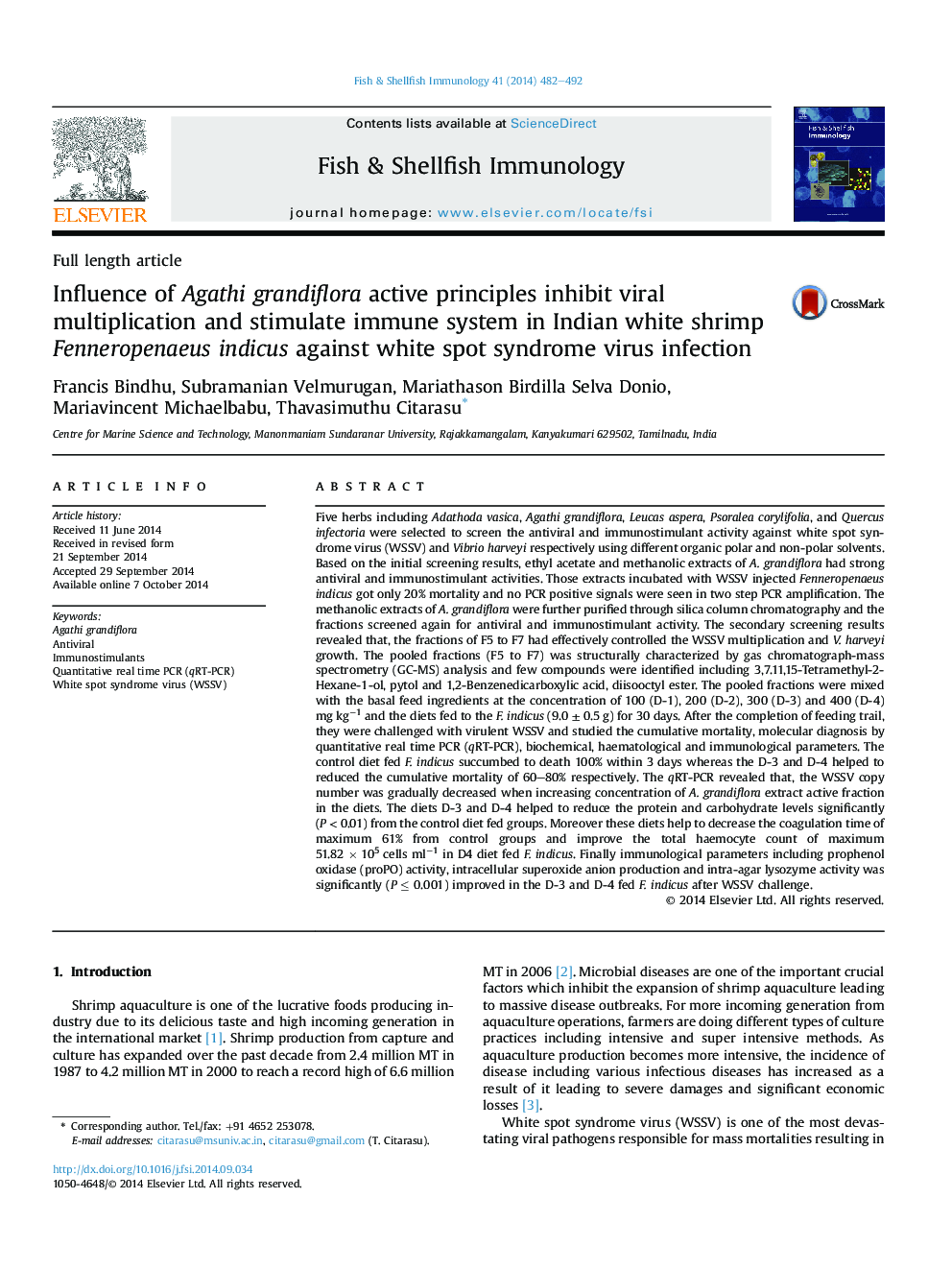| کد مقاله | کد نشریه | سال انتشار | مقاله انگلیسی | نسخه تمام متن |
|---|---|---|---|---|
| 2430956 | 1106740 | 2014 | 11 صفحه PDF | دانلود رایگان |

• Antiviral and immunostimulant activities were characterized from Agathi grandiflora.
• They were effectively controlled WSSV by in vitro and in vivo levels.
• The antiviral and immunostimulant compounds were characterized.
• The compounds enriched diets improved the resistance against WSSV in shrimps.
• The diets also help to stimulate the immune system against WSSV infection.
Five herbs including Adathoda vasica, Agathi grandiflora, Leucas aspera, Psoralea corylifolia, and Quercus infectoria were selected to screen the antiviral and immunostimulant activity against white spot syndrome virus (WSSV) and Vibrio harveyi respectively using different organic polar and non-polar solvents. Based on the initial screening results, ethyl acetate and methanolic extracts of A. grandiflora had strong antiviral and immunostimulant activities. Those extracts incubated with WSSV injected Fenneropenaeus indicus got only 20% mortality and no PCR positive signals were seen in two step PCR amplification. The methanolic extracts of A. grandiflora were further purified through silica column chromatography and the fractions screened again for antiviral and immunostimulant activity. The secondary screening results revealed that, the fractions of F5 to F7 had effectively controlled the WSSV multiplication and V. harveyi growth. The pooled fractions (F5 to F7) was structurally characterized by gas chromatograph-mass spectrometry (GC-MS) analysis and few compounds were identified including 3,7.11,15-Tetramethyl-2-Hexane-1-ol, pytol and 1,2-Benzenedicarboxylic acid, diisooctyl ester. The pooled fractions were mixed with the basal feed ingredients at the concentration of 100 (D-1), 200 (D-2), 300 (D-3) and 400 (D-4) mg kg−1 and the diets fed to the F. indicus (9.0 ± 0.5 g) for 30 days. After the completion of feeding trail, they were challenged with virulent WSSV and studied the cumulative mortality, molecular diagnosis by quantitative real time PCR (qRT-PCR), biochemical, haematological and immunological parameters. The control diet fed F. indicus succumbed to death 100% within 3 days whereas the D-3 and D-4 helped to reduced the cumulative mortality of 60–80% respectively. The qRT-PCR revealed that, the WSSV copy number was gradually decreased when increasing concentration of A. grandiflora extract active fraction in the diets. The diets D-3 and D-4 helped to reduce the protein and carbohydrate levels significantly (P < 0.01) from the control diet fed groups. Moreover these diets help to decrease the coagulation time of maximum 61% from control groups and improve the total haemocyte count of maximum 51.82 × 105 cells ml−1 in D4 diet fed F. indicus. Finally immunological parameters including prophenol oxidase (proPO) activity, intracellular superoxide anion production and intra-agar lysozyme activity was significantly (P ≤ 0.001) improved in the D-3 and D-4 fed F. indicus after WSSV challenge.
Journal: Fish & Shellfish Immunology - Volume 41, Issue 2, December 2014, Pages 482–492